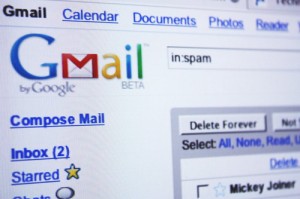
In our relentless quest to get a prospects’ attention we need to engage in strategies that achieve this but also not be an annoyance at the same time! As sales executives we know we’re always walking a fine line between the two when pushing messages out to our prospects. I’m a big believer in email as an alternative to cold calling because of a few reasons:
- the email is delivered to your prospects’ inbox vs a cold call is screened by your prospects’ call-display unit
- the email message remains in your prospects’ inbox until he or she has time to read it and respond (or delete it but if you follow what I’m going to outline here then you will minimize the chances of that happening!)
- the email is MUCH more likely to be responded to than a voicemail
- the email has a much larger chance of bypassing spam filters if it’s personalized.
If you have not had success with emailing your prospects in the past it could be for a number of reasons. The most likely reasons for emails being ignored or promptly deleted are:
- When they’re part of a mass generic email blitz. There’s just little to no room for customization in these.
- Asking your customer to call you or telling him you will call to follow up after sending an email that tells them all about your company.
The trick to successful prospecting through emails is to have the proper format. Once I started working with this format my results went up immediately as did those of the hunter sales reps I worked with. When you use this format you can expect many more responses than with the emails that you usually send and infinitely more than with straight cold-calling.
Although this may not surprise you but salespeople will still send out multiple emails without enough of the key elements to include in a personalized message to get their emails read.
The successful format that produces more reads and responses goes something like this:
Step 1: Start the body of your email. Type up something that conveys the value you and your organization can deliver. We will revisit this again later but for now just get started with something. Use simple yet professional language when typing up your email.
Step 2: Keep your emails short! No more than 3-4 short paragraphs. And heed the paragraph rule and use spaces because the email will look easier to digest.
Step 3: Create an attention getting headline. Don’t be afraid to use their company name in the subject line as that is more customization. The subject line should be something that could be top of mind with the prospect. What is affecting their industry? What is challenging their business? What solutions have you provided that has really benefited others in the same position as your prospect? Create a non-generic subject line that will make the prospect want to at least open the email and see if what’s inside is worth reading!
Step 4: Let’s revisit what you created from Step #1. The body of your email should explain in a few short paragraphs:
- How you understand something about their business and industry. This will prove to your prospect that you have at least done something in terms of homework or research on them. It also communicates that they’re dealing with a real person and not a spam attempt where the email they’re reading is one of several thousand that were launched that day.
- What your solution is and how it’s helped others. Do not go on and on about you or your company but rather focus on the results that you think you can deliver.
Step 5: Now that you hopefully will be earning your prospect’s attention and she is eager to learn more you should include a ‘call to action’. This is where you ask your prospect to take action and receive something that will benefit her. Examples of this might be an invite to a free webinar, a free download such as a whitepaper or report chalk full of information. Perhaps a video that will turn on some light bulbs in your prospects’ mind. The power of ‘free’ is really powerful with calls to action. Add this at the end of your email.
Step 6: Fire off your email and see if your prospect responds. If not then feel free to send a follow up in about a week or if you’re so inclined then pick up the phone to deliver a ‘warm-call’.
A good first value-providing email should be able to break some ice and get the ball rolling for a conversation to happen sooner or later when the prospect is ready -which ultimately your prospect will decide. If your first few attempts at creating engaging emails does not yield the responses you want or need then experiment with the content within your email. Change it up from time to time and see what content your prospects are responding to.
Stop cold calling and get more sales prospecting resources at www.ihatesalesprospecting.com.
 Mark is a global solutions consultant in high tech sales for one of the world’s largest Fortune 100 companies. He is also heavily involved with marketing and training for their sales organization. During his tenure he has seen many corporate sales strategies succeed as well as fail, and takes an evangelic approach to sales and the fine art of getting yourself in front of real prospects. Mark prefers to take the mystery out of sales prospecting and pokes holes in traditional techniques that are either outdated due to new technologies or just plain ineffective.
Mark is a global solutions consultant in high tech sales for one of the world’s largest Fortune 100 companies. He is also heavily involved with marketing and training for their sales organization. During his tenure he has seen many corporate sales strategies succeed as well as fail, and takes an evangelic approach to sales and the fine art of getting yourself in front of real prospects. Mark prefers to take the mystery out of sales prospecting and pokes holes in traditional techniques that are either outdated due to new technologies or just plain ineffective.






Add Comment